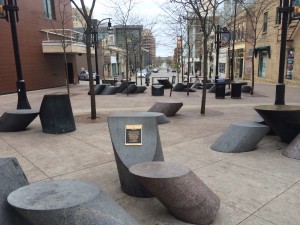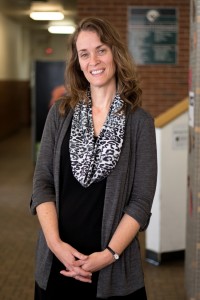At the top of State Street in Madison, beneath the shadow of the towering Capitol building, a collection of metal and stone benches jutted out from the cold concrete near West Mifflin Street, marking a meeting place that served the city for more than 10 years. Jill Sebastian, who created the installation in 2004, envisioned it as a “gathering place to debate ideas,” and called it Philosopher’s Grove.
Ironically, Philosopher’s Grove itself fell victim to debate after it became a favorite settling spot of homeless Madisonians. In August 2015, city crews armed with forklifts descended on the grove, extracted the stones one by one and set them neatly on the back of trucks. The city’s effort to cut back on criminal activity in the space had the unintended consequence of displacing the homeless — a group that Madison has struggled to address.
As Madison’s homeless population has risen — by 40 percent in the last five years — the giving spirit of a city long touted as one of the most progressive in America has been tested time and time again, culminating now in measures some believe are designed to fix symptoms on the surface of a deep-seated problem.
“I understand what the city thinks. They don’t want the cops to have to come [to the Grove] all the time because there’s fighting,” says Lynnette Leisure, a homeless woman in Madison who currently lives in transitional housing. “At the same time, you’re taking away every place for homeless people to go. Where do you think they’re gonna go next?”
‘Visible now’
The removal of Philosopher’s Grove is just one aspect of the city’s recent efforts to address issues related to homelessness. On Oct. 1, homeless residents were banned from sleeping in front of the City County Building, which had become a popular place for those who were unable to get into shelters to spend the night. In July, Madison Mayor Paul Soglin proposed a one-hour sitting limit on public benches and sidewalks, a measure that was struck down by the Madison Common Council in a joint meeting in October.
“I don’t know everyone’s responsibility, but I feel a responsibility for 245,000 people and our visitors,” Soglin told the council in defense of his proposal, which was designed to give police leverage in dealing with poor behavior from a small group of homeless people. “I don’t think it’s asking too much for these kinds of behaviors to cease, with all the money we’re spending and all the requests that have been met.”
For the city’s part, much of its homelessness problem is not due to its own inaction, but circumstances that have emerged and shaped Madison’s identity over the last 10 years. As recently as 2005, the city’s vacancy rate matched that of the current national rate, around 7 percent. But now, Madison has one of the lowest vacancy rates in the country: According to data from Madison Gas & Electric, approximately 3 percent of the properties it served were vacant in the third quarter of 2015. In 2014, it dipped below 2 percent. This dearth of housing has driven a housing boom in Madison’s most desirable ZIP codes, but little of it, if any at all, is designed with affordability in mind.
“There is a lot of housing being built, none of which would be affordable to our clientele,” says Karla Jameson, the director of services at Porchlight Inc., a nonprofit that runs some of the city’s largest programs and shelters for the homeless
Jameson has been working at Porchlight for 25 years. Her interest in the issue of homelessness was sparked by a high school class trip to New York City, where a homeless man asked her and her friends for a dollar while they looked at sunglasses for sale on the street.
“Eventually we just started walking away, and he started to follow us,” Jameson says. “And he kept saying ‘I know you hear me. Don’t pretend like you don’t hear me. I just need a dollar, I haven’t had anything to eat today.’”
The girls refused him the dollar, but another man walking by finally obliged.
“I remember our judgmental selves. We literally turned around and said, ‘Oh, I’m sure he’s going to buy cigarettes or beer’ — you know, he had a dollar. But we just had to justify why we couldn’t give him the dollar. And he walked up to the hot dog stand and bought a hot dog. And it was the most profound moment of my life.”
From there, Jameson got her bachelor’s degree in social work from Winona State University and her master’s in social work from UW-Madison. Her first job out of school was at Porchlight’s Hospitality House, and she’s been with the organization ever since.
Part of the problem homeless Madisonians now face, according to Jameson, is that affordable housing is much harder to find compared to when she first started at Porchlight.
“I literally would say, ‘Why don’t you go get a job, and I’ll help you find housing.’ They’d come back the next day with a job. I mean, it was that easy,” Jameson says. “Maybe they needed my help getting ID, or work boots, and those were the things we would work on … Not that it was easy to find housing [then], but it is next to impossible to find housing [now].”
Despite the city’s lack of affordable housing, Madison has a reputation in the Midwest as a “mecca of homeless services,” according to Kim Sutter, coordinator at Porchlight’s Safe Haven, a transitional shelter for homeless people with mental illness.
“While it’s not as big of a problem as the mayor would make it out to be, people do come from other parts of the state, and other states, to get services here, because they hear it’s a great place,” Sutter says. “However, we are not a great place for housing. So those two things are disconnected.”
Sutter says that while there are plentiful services in Madison, they’re often spread around the city and duplicated among providers, creating a confusing environment with little organization.
“While it’s great that we have a lot of services, it’s not great that the homeless individual is responsible for navigating that,” Sutter says.
Madison, as a reputable college town, also has an intellectual climate that worsens homeless Madisonians’ prospects, according to Jameson. During her time at Hospitality House, she was surprised to discover how many of the homeless people she worked with had learning disabilities or a lack of employability skills. Once Porchlight is able to house these people, it connects them with services they need to get their GEDs. But they run into problems even then, says Jameson, because so many of the entry-level and hourly jobs in the city are filled by students attending the university.
These factors, according to Jameson, have catalyzed the recent growth of Madison’s homeless population.

Philosopher’s Grove, which was razed in the summer of 2015. Photo by Sarah Zimmermann, The Badger Herald.
“The thing I notice now, different from my first few years, is the number of homeless people on the streets,” Jameson says. “There are so many now compared to 10, 15, 20 years ago. I do not recall that even being an issue, or they certainly weren’t so visible. I mean, the homeless in Madison are visible now.”
‘Everything fell through’
While many of Madison’s homeless either choose to sleep on the streets or end up there by chance, some find themselves in transitional housing, like Lynnette Leisure. Leisure, who’s lived in Porchlight’s Brooks Street shelter since February of 2015, is one of many homeless Madisonians native to the city who simply fell on hard times. She lived in Madison for nearly 20 years, moved briefly to North Carolina in 2012, and returned to the city in 2014 after she and her brother became homeless.
“We figured, ‘Well, hell, if we’re gonna be homeless, we might as well be homeless in a state where we got people that we think will help us out,’” Leisure says. “Everything fell through the second we got here.”
Mental health is yet another aspect of the city’s homelessness problem that complicates seemingly simple tasks, like seeking support services for their mental illness or searching for housing.
“They come to us in various levels of stability when it comes to their mental illness,” Sutter says. “We serve people who have ADHD, and that prevents them from sitting down and getting through an application. And then we have people who have bipolar disorder, where maybe one day they’re doing lots and lots and the next day they’re unable to function in any way. And then we have people with schizophrenia who have pretty intense delusions.”
Safe Haven houses 14 residents and provides daytime services to other homeless people struggling with mental illness. With the average resident’s stay clocking in around six to eight months, the waiting list to get a bed at Safe Haven — and other places like it — is long.
Leisure spent time in the single women’s shelter run by the Salvation Army as well as Porchlight’s Safe Haven. She suffers from post-traumatic stress disorder, bipolar disorder, borderline personality disorder and anxiety.
“It seems like what happens in Madison is we identify an issue, we funnel a whole bunch of time and money into that, it fills up, and then we have the same problem again,” Sutter says.
Along with the task of finding permanent housing, homeless people with mental illness must also find a doctor to prescribe their medications. Most homeless Madisonians are now covered under BadgerCare, which is a health insurance program for low-income Wisconsinites provided by the Wisconsin Department of Health Services. But the influx of people with insurance seeking resources means that some of the mentally ill are left waiting — sometimes up to several months — for medication, which can have disastrous effects for people like Leisure.
“I take my medicines. I know what happens when I don’t take medicines,” Leisure says. “It’s awful. Not just for me, but for my family.”
‘I kind of see us making a dent here’
Even though homelessness in the city appears from the outside to be getting worse, Madison is on the precipice of breaking through.
For many of the city’s homeless advocates, the longest and hardest fight for more resources has been the push for a centralized daytime resource center in downtown Madison. Porchlight’s Hospitality House qualifies as a day center, according to Jameson, but it’s about three miles from downtown, and it doesn’t have things like lockers, showers and washing machines that advocates say are essential. Dane County recently settled on a building to convert into a day center, the old home of Messner’s Inc., on East Washington Avenue, and is waiting for its bid to be accepted. As with other sites that the county has investigated, neighbors of the building are fighting the proposal, but Jameson said the aim is to keep moving forward.
“The plan is that they purchase it and start renovation right away, and that next year, by November 1 of 2016, we will have a day resource center,” Jameson says.
Meanwhile, Porchlight is making headway in affordable housing.
This year, the organization partnered with the Community Development Authority to build and manage eight units of affordable housing, and the units welcomed their first residents in October of 2015. Porchlight also purchased land by East Towne Mall, where it plans to build at least 30 units of affordable housing within the upcoming year.
“I kind of see us making a dent here,” Jameson says. “Next year at this time … I think that I would be able to say we saw a nice reduction in homelessness for singles. We still need to do work on family housing.”
The homeless community has also thought of creative solutions on their own. Occupy Madison Inc., the city’s segment of the Occupy Wall Street Movement that sprung up in 2011 to rally against income inequality, completed its first tiny house in 2013. Now, Occupy Madison owns property on East Washington Avenue, where five people live in three 98-square-foot tiny homes. The organization expects to grow in the coming years and hopes to eventually add five more tiny homes and a small community center. Neighbors’ initial fears about tiny home residents disrupting neighborhood life never materialized.
In the midst of criticism coming from all sides on the issue of homelessness, the city itself is also building new units of affordable housing in the coming months. Madison has partnered with Heartland Alliance, an anti-poverty group in Chicago, to construct 60 subsidized units for homeless residents on Rethke Avenue. It has plans to construct nearly 1,000 more units within the next five years, which Soglin says might take care of “everyone out there who’s homeless … now.”
For homeless Madisonians like Leisure, there is still hope. When she’s not in meetings with her caseworker, she’s searching for a job, sometimes trekking up to the Capitol Square — near the hauntingly empty stretch of concrete where Philosopher’s Grove once stood — to research job opportunities at the Madison Public Library. She dreams of someday becoming a receptionist at a veterinary clinic.
Still, she feels the sting of the stigma surrounding homelessness, even in a place as progressive as Madison.
“We’re people,” Leisure says when asked what she’d want people to know about the homeless. There is a hint of sad desperation in her voice. “We’re like everybody else, we’re people. We may have additional issues that we have to face every day … but that doesn’t mean we’re any less of a person.”

